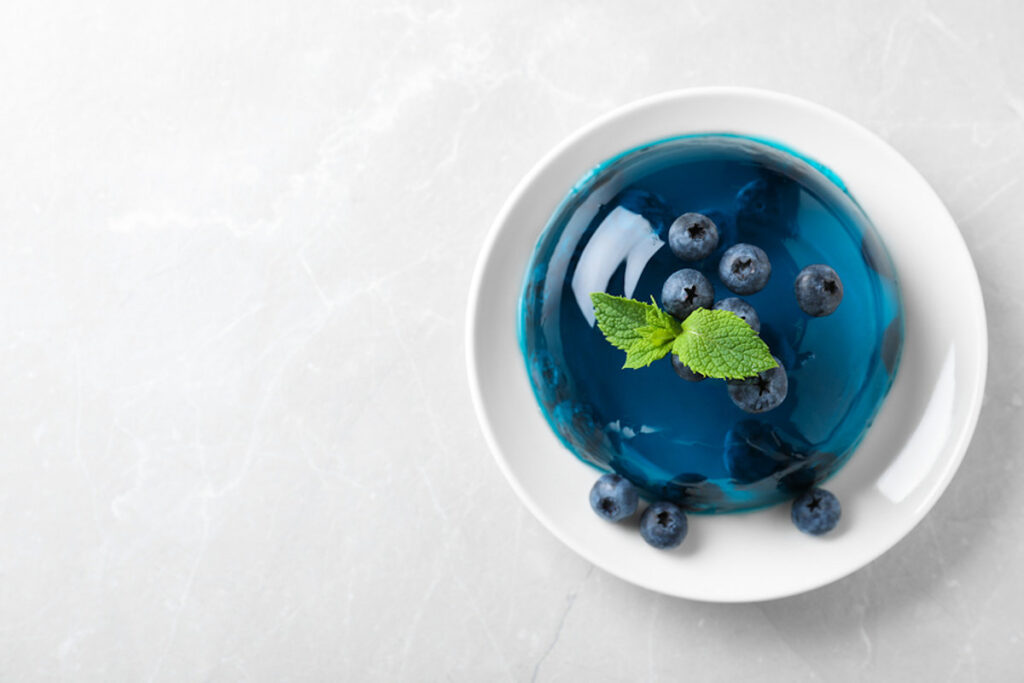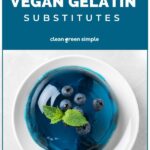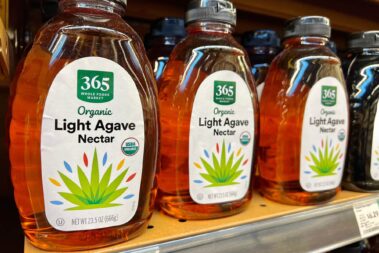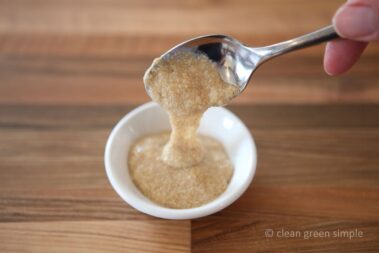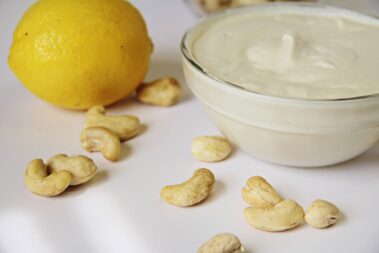From homemade Jell-O to chocolate mousse, many sweets call for gelatin as an ingredient. But what happens if you eat a vegan or vegetarian diet? After all, gelatin is made from boiling animal parts—such as bones, tendons, and cartilage—to extract a protein called collagen.
But thanks to these eight vegan gelatin substitutes, you can have your Jell-O (or other gelatin-based dessert) and eat it too.
Table of Contents
Vegan Gelatin Substitutes
1. Agar agar
Agar agar, also known as katen or agar, is a flavorless jelly-like substance. It comes from the cell walls of red algae and is semi-translucent. In Asia, agar agar is widely used in custards, jellies, and puddings.
Since it’s made from algae, agar agar is an excellent gelatin substitute (it’s our favorite for making vegan jello). It’s used to gel, emulsify, and thicken foods. Agar is usually available as flakes or powder, but you can find it in bar or sheet form too.
Agar is firmer than gelatin. It’s also not as “jiggly.” However, it’s the most popular vegan alternative to gelatin.
How to use agar agar
To use agar, simply dissolve it in hot liquid like water. Let it sit for about 60 minutes until it firms up. You don’t need to store it in the refrigerator.
Generally, agar agar powder replaces gelatin at a 1:1 ratio. In other words, if you need 2 teaspoons of gelatin, use 2 teaspoons of powdered agar agar. If you’re using agar agar flakes, use 1 tablespoon for every 1 teaspoon of agar agar powder.
For best results, follow the recipe instructions or the directions on the packaging.
Best option on Amazon:

2. Pectin
Pectin is a fiber that’s found in the cell walls of many fruits. When pectin is heated and mixed with acids and sugars, it forms a thick gel-like substance. It’s a popular, common ingredient in store-bought jellies and jams.
Commercial pectin, which usually comes from apples and citrus fruits, is available as powder or flakes. It’s also used as a thickening, gelling, and stabilizing agent.
Compared to gelatin, pectin is more gummy and syrup-like.
How to use pectin
Like agar, pectin needs to be boiled in order to gel. However, there isn’t an exact substitution ratio, so it’s best to follow the recipe’s directions.
Best option on Amazon:

3. Carrageenan
Carrageenan, also known as carrageen or Irish moss, comes from dried red seaweed. Like agar, it develops a gel-like consistency once it’s boiled.
In fact, carrageenan is added to many store-bought foods. Products like ice cream, frozen pizza, marshmallows and chocolate milk are often made with it. And while these foods aren’t traditionally vegan, carrageenan certainly is.
This gelatin substitute is available as a powder. Compared to normal gelatin, the texture of carrageenan is softer.
How to use carrageenan
To prepare carrageenan, mix it with liquid then heat. For softer foods, like puddings or custards, it’s best to use iota carrageenan. For firmer foods, use kappa carrageenan. The latter is often used to make homemade vegan cheese.
Best option on Amazon:

4. Vegan Jel
Vegan jel is a type of product, rather than a single ingredient. Depending on the brand, it may contain ingredients like vegetable gum, carrageenan, and tapioca dextrin.
Usually, store-bought vegan jel yields the closest consistency and texture to normal gelatin. The product, after all, was designed for this exact purpose!
How to use vegan jel
Since the ingredients vary by brand, it’s best to follow the package’s directions. The powder is typically mixed with cold water until it’s dissolved.
Best option on Amazon:

5. Cornstarch
If you’re making a recipe (like fruit sauce or chocolate mousse) that uses gelatin as a thickener, you can use cornstarch instead. As the name suggests, the ingredient is the starch (carbohydrate) from corn grains. When mixed with liquid, the cornstarch absorbs moisture and expands, which creates a thickening effect once heated.
That being said, cornstarch can’t be used to make jello-like recipes. It also doesn’t set as it cools.
How to use cornstarch
To use cornstarch as a thickener, mix equal parts cornstarch and water. Add it to your recipe as it cooks; the heat will activate the cornstarch.
Cornstarch can’t replace gelatin at a 1:1 ratio, so you’ll want to use this method with more adaptable recipes like sauces and creams. Otherwise, consider following recipes that list specific measurements and ratios for cornstarch.
Best option on Amazon:

6. Xanthan Gum
Gluten-free cooks will recognize xanthan gum, a natural powdered thickener. It’s made when Xanthomonas campestris, a strain of bacteria, ferments sugar from ingredients like rice or corn. The resulting xanthan gum can be rehydrated with water, which turns it into a sticky substance that can thicken or stabilize recipes.
Like cornstarch, xanthan gum won’t create a gel. But you can use it in place of gelatin in homemade syrups, baked goods, ice creams, cheesecakes, and sauces.
How to use xanthan gum
When replacing gelatin with xanthan gum, use half the amount. For example, if a recipe uses 3 teaspoons of gelatin, you’ll need 1 1/2 teaspoons of xanthan gum.
Note that xanthan gum will immediately gel when mixed with liquid.
Best option on Amazon:

7. Guar Gum
Guar gum, or guaran, is powder made from the cluster bean. The gum has a substance called galactomannan, which becomes a thickener and stabilizer when mixed with water.
This ingredient is a great option when you need the thickening properties of gelatin. It will also give structure to baked goods and pastries, like pancakes and cookies.
How to use guar gum
The best amount of guar gum depends on the recipe. In general, you’ll need a lot less (about 1/5 as much) guar gum than gelatin. Additionally, 1 cup of liquid can be thickened with 1/2 teaspoon of guar gum.
Best option on Amazon:

8. Instant Clear Jel
Instant clear jel is essentially modified cornstarch. But unlike traditional cornstarch, it’s pre-cooked, so it doesn’t need to be heat to be activated. This means it’s ideal for thickening no-cook recipes, like refrigerator cream pies, though some versions can be used for recipes that are heated.
As with other gelatin alternatives on this list, instant clear jel can’t be used to make a firm and jiggly dessert like Jell-o. Instead, it creates a stablized gelatin texture.
How to use instant clear jel
To be safe, follow the directions on the packaging or in your recipe. In most cases, you’ll need to mix 1 tablespoon instant clear jel for every 1 cup of liquid.
Best option on Amazon:

Our Expert Opinion: The Best Vegan Gelatin Substitute
There are a surprising number of vegan-friendly gelatin substitutes out there. But the best, in my opinion, is agar agar.
This algae-derived product can be used to replace gelatin at a one-to-one ratio in just about any recipe. It has a very similar texture to real gelatin and is by far the most versatile of all the choices above.
If you follow a vegan diet, make sure you have a bag of agar agar in the pantry just in case.
Druids Grove Vegan Gelatin
If you’re looking for an alternative option for substituting gelatin, one simple solution is this great vegan gelatin product from Druids Grove.
This carrageenan-based product is made to be a simple one-to-one substitute for gelatin in any recipe. It is easy to use and has a great texture. I’ve found it is an especially good option for making homemade vegan gummy bears.
It doesn’t work so well for vegan marshmallows, however. If that’s what you’re trying to do, I recommend checking out this recipe for Easy Vegan Marshmallows.
FAQ
Can you use vegan gelatin at a one-to-one ratio?
Often you can use vegan gelatin substitutes and products at a one-to-one ratio to real gelatin. However, it is best to reference the box for amount recommendations based on recipes. If using agar agar or another simple substitute, I recommend finding a vegan recipe that incorporates that substitute in the instructions.
Is gelatin kosher?
Gelatin is often not kosher. This is usually because it is made from parts of non-kosher animals, such as pigs, or from animals that were not kosher-slaughtered. If you follow a kosher diet rather than a vegan diet, you can still use many of the substitutes outlined above.
What Jello option is vegan?
Simply Delish and Bakol are two of the most popular vegan Jello brands out there. But, as veganism becomes more popular, more and more plant-based Jello options are popping up.
Our Favorite Gelatin-Free Desserts
Let’s be honest, gelatin-containing desserts are popular for a reason—that texture just works!
If you’re trying to avoid animal-based products, here are some delicious desserts that taste like they contain gelatin but are actually 100% vegan.
- Vegan Jello – Agar agar is the star of this super-easy vegan Jello recipe.
- Vegan Pumpkin Pie – A little cornstarch goes a long way to make this flavorful vegan pumpkin pie taste just as good as traditional recipes.
- Coconut Milk Whipped Cream – This vegan whipped cream uses just three simple plant-based ingredients.
- Vegan Chocolate Mousse – This decadent chocolate mousse captures the texture of the real thing thanks to highly versatile aquafaba.
- Creamy Vegan Lemon Bars – Cornstarch and a little fat from coconut milk give these lemon bars that smooth, satisfying texture you crave.
Loving these recipes or in search of more vegan substitutes? Don’t forget to sign up for our newsletter to get delicious plant-based recipes and tips delivered to your inbox.
Plant-Based Gelatin Substitutes
With so many great vegan gelatin substitutes out there, there’s nothing holding you back from creating any vegan dessert you crave. I prefer to use agar agar in most of my recipes, but cornstarch, pectin, and others have their place in vegan baking as well.
What is your favorite vegan gelatin substitute? Let us know by posting in the comments section below.
- 18 Scrumptious Vegan Thanksgiving Desserts - November 16, 2023
- 25 Vegan Thanksgiving Sides to Complete Your Holiday Dinner - November 16, 2023
- Best Vegan Frozen Food Meals at Trader Joe’s - October 17, 2023

